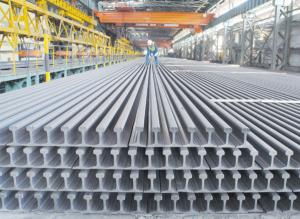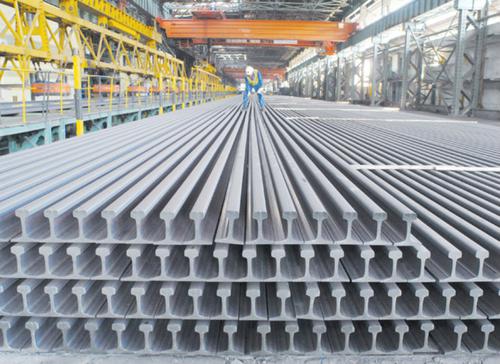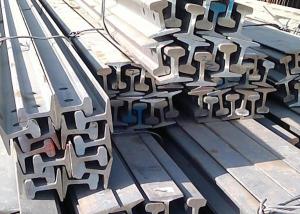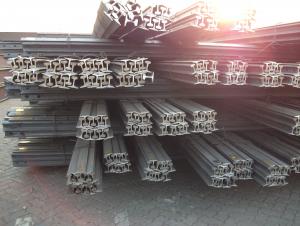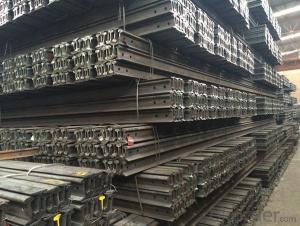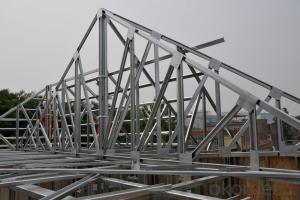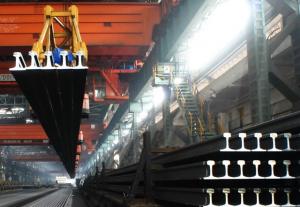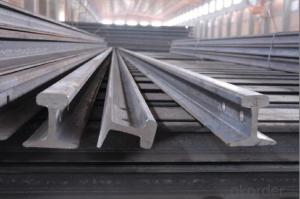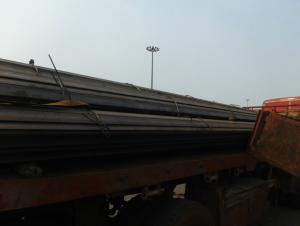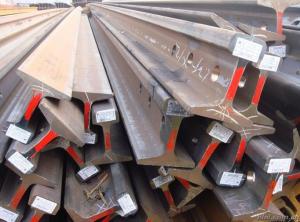Steel Light Rail wfith High Quality for Construction
- Loading Port:
- China main port
- Payment Terms:
- TT or LC
- Min Order Qty:
- 25 m.t.
- Supply Capability:
- 100000 m.t./month
OKorder Service Pledge
OKorder Financial Service
You Might Also Like
Specifications of Steel Light Rail wfith High Quality for Construction:
Production Standard: GB11264-89
Material: Q235, 55Q
Grade | Element(%) | ||||
C | Mn | S | P | Si | |
Q235 | 0.12—0.20 | 0.3—0.7 | ≤0.045 | ≤0.045 | ≤0.3 |
55Q | 0.50—0.60 | 0.70—1.00 | ≤0.050 | ≤0.045 | 0.15-0.35 |
Sizes: 9kg, 12kg, 15kg, 22kg, 30kg
Length: 6M, 8M, 10M, 12M or as the requriement
Invoicing on theoretical weight or actual weight as customer request
Payment terms: 30% advance payment by T/T, 70% payment against the copy of the B/L; 100% L/C at sight, etc.
Applications of Steel Light Rail wfith High Quality for Construction:
Light Steel Rail is mainly used in forest region, mines, factories and construction sites laid of the place such as temporary transport line and light motorcycles with line, for example:
railway, subway, transportation track, express, curve way, tunnel way.
Package & Delivery of Steel Light Rail wfith High Quality for Construction:
1. Package: it is nude packed in bundles by steel wire rod
2. Bundle weight: not more than 3.5MT for bulk vessel; less than 3 MT for container load
3. Marks:
Color marking: There will be color marking on both end of the bundle for the cargo delivered by bulk vessel. That makes it easily to distinguish at the destination port.
Tag mark: there will be tag mark tied up on the bundles. The information usually including supplier logo and name, product name, made in China, shipping marks and other information request by the customer.
If loading by container the marking is not needed, but we will prepare it as customer request.
4. Transportation: the goods are delivered by truck from mill to loading port, the maximum quantity can be loaded is around 40MTs by each truck. If the order quantity cannot reach the full truck loaded, the transportation cost per ton will be little higher than full load.
5. Delivered by container or bulk vessel
6. Delivery Time: All the Hot Rolled Steel Rail will be transpoted at the port of Tianjin, China within 30 days after receiving the advance payment by T/T or the orginal L/C at sight.
Production flow of Steel Light Rail wfith High Quality for Construction:
Material prepare (billet) —heat up—rough rolling—precision rolling—cooling—packing—storage and transportation
FAQ:
Q1: How do we guarantee the quality of our products?
A1: We have established an advanced quality management system which conducts strict quality tests at every step, from raw materials to the final product. At the same time, we provide extensive follow-up service assurances as required.
Q2: How soon can we receive the product after purchase?
A2: Within three days of placing an order, we will begin production. The specific shipping date is dependent upon international and government factors, but is typically 7 to 10 workdays.
Q3: What makes stainless steel stainless?
A3: Stainless steel must contain at least 10.5 % chromium. It is this element that reacts with the oxygen in the air to form a complex chrome-oxide surface layer that is invisible but strong enough to prevent further oxygen from "staining" (rusting) the surface. Higher levels of chromium and the addition of other alloying elements such as nickel and molybdenum enhance this surface layer and improve the corrosion resistance of the stainless material.
Images:

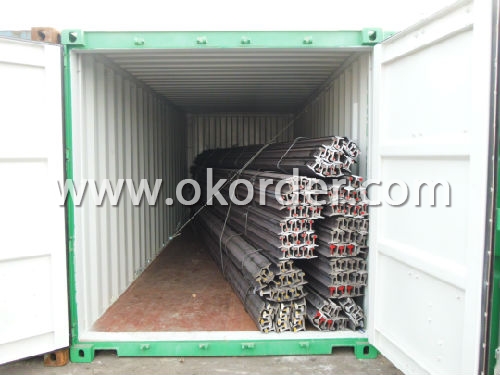
- Q: How do steel rails contribute to the overall stability of a railway track?
- The overall stability of a railway track greatly depends on steel rails. They serve as a solid foundation for train wheels, ensuring smooth and safe movement. Let's explore the various ways in which steel rails contribute to track stability: 1. Strength and Durability: Steel rails are specifically designed to withstand heavy loads and high impact forces. Their exceptional tensile strength enables them to bear the weight of trains and evenly distribute it along the track. This strength ensures that the rails remain intact and do not deform under pressure, thereby maintaining track stability. 2. Alignment and Gauge Control: Steel rails are manufactured with precision to maintain a consistent track gauge, which is the distance between the inner sides of the rails. The accurate alignment and gauge control facilitated by steel rails ensure that trains stay on track and do not derail. This alignment stability is crucial for the safe and smooth functioning of the railway system. 3. Support for Track Formation: Steel rails are securely attached to sleepers or ties, providing support and stability to the track formation. The sleepers evenly distribute the load from the rails to the underlying ballast or subgrade, preventing excessive movement or settlement of the track. This support system, combined with the rigidity and strength of steel rails, helps maintain track stability. 4. Continuous Welded Rails: In modern railway systems, steel rails are often welded together to form continuous rails, eliminating joints or gaps between rail sections. This continuous welded rail (CWR) technology reduces the risk of rail failures, such as rail breaks or rail creep, which can lead to track instability. CWR also enhances the overall stability and comfort of the railway track, providing a smoother and quieter ride for trains. In conclusion, steel rails play a crucial role in maintaining the overall stability of a railway track. Their strength, alignment control, track formation support, and the use of continuous welded rails all contribute to safe and efficient train operations, enhancing the stability of the entire railway system.
- Q: How are steel rails protected from impact damage?
- Steel rails are protected from impact damage through various measures. One common method is the use of resilient materials such as rubber or polyurethane pads placed between the rail and the supporting structure. These pads absorb some of the impact energy and distribute it over a larger area, reducing the stress on the rail. Another method is the application of impact-resistant coatings on the surface of the rail. These coatings are typically made of materials such as epoxy or polyurethane, which provide a protective layer that can absorb and disperse the energy from impacts. In addition, steel rails are often designed to have a certain degree of flexibility to withstand impact forces. This flexibility allows the rail to absorb some of the energy from impacts and distribute it along the length of the rail, reducing the risk of damage. Regular maintenance and inspections are also crucial in protecting steel rails from impact damage. Inspections can identify any potential issues, such as loose or damaged components, and allow for timely repairs or replacements to be made. Overall, a combination of resilient materials, impact-resistant coatings, flexible design, and regular maintenance are employed to protect steel rails from impact damage and ensure their longevity and safety.
- Q: Why are some city railways called light rail? What is heavy rail?
- The rail is divided into two kinds of heavy rail and light rail. The rail specification is expressed by the nominal weight per meter.Heavy rail: the nominal weight of more than 30 kg per meter, rail belongs to heavy rail, heavy rail is divided into general rail and crane rail two. General rail means rail laying, dedicated lines, bend and tunnel rails. Among them, the standard track length is 12.50 meters and 25 meters in two, the laying of the curve rail, slightly shorter length, 12.46 meters, 12.42 meters and 24.96 meters, 24.92 meters and other rail, general specification for 38, 43, 45, 50, 60 (kg / m).
- Q: Are steel rails fire-resistant?
- Yes, steel rails are fire-resistant. Steel is a non-combustible material, meaning it does not burn or contribute to the spread of fire. This makes steel rails an ideal choice for railroad tracks, as they can withstand high temperatures and intense heat without weakening or melting. In the event of a fire, steel rails will not add fuel to the fire or compromise the structural integrity of the tracks. Additionally, steel's resistance to fire makes it a safer option for railway systems, reducing the risk of accidents and ensuring the reliability and durability of the tracks.
- Q: How are steel rails protected against biological corrosion?
- Steel rails are protected against biological corrosion through the use of anti-corrosion coatings, such as epoxy or zinc, which act as a barrier between the steel surface and the environment. Additionally, regular maintenance practices, including cleaning and inspection, help to prevent the buildup of organic matter or microorganisms that could promote corrosion.
- Q: Cause analysis of manganese stiffness in rail
- In the manufacture of rail, in addition to adding more manganese, in the upper rail, the layer and is contacted with a wheel, but also added another kind of metal, indium, it added to the rail on the part of the hardness of the case, even has some toughness, the train wheel is very important it is time, and the "tire" contact, collision, there will be some flexibility, to ensure the safe operation of the train.
- Q: How do steel rails handle the effects of heavy braking and acceleration?
- Steel rails are designed to withstand the effects of heavy braking and acceleration on trains. The high tensile strength of steel allows the rails to absorb and distribute the forces generated during these actions, preventing excessive wear or deformation. Additionally, steel rails are typically installed with proper fastening systems and regularly maintained to ensure their stability and durability under such conditions.
- Q: How do steel rails contribute to reducing track settlement issues?
- There are several ways in which steel rails contribute to the reduction of track settlement issues. To begin with, steel rails possess greater strength and rigidity compared to other rail track materials like wooden sleepers. This strength and rigidity assist in evenly distributing the weight of trains along the track, thereby preventing excessive pressure on specific points and decreasing the chances of settlement. Furthermore, steel rails are designed to be highly durable and resistant to wear and tear. Consequently, they can maintain their shape and structure for extended periods, even when subjected to heavy train traffic. Consequently, they are less susceptible to deformation or sinking into the ground, which can result in track settlement. Moreover, steel rails are typically installed on well-engineered ballast beds. These ballasts provide a stable and supportive foundation for the rails, aiding in the even distribution of the load and mitigating settlement. Additionally, the ballast facilitates proper drainage, reducing the risk of water accumulation and subsequent softening of the ground beneath the track. In addition, regular inspections and maintenance are conducted on steel rails to ensure their integrity. Any signs of settlement or deformation are promptly identified and addressed, preventing further track settlement issues from arising. Overall, the utilization of steel rails in rail tracks significantly reduces the likelihood of track settlement problems due to their strength, durability, and the presence of supporting ballast beds. This, in turn, guarantees the long-term stability and safety of the railway infrastructure.
- Q: How are steel rails inspected for track gauge accuracy?
- Steel rails are inspected for track gauge accuracy by using special gauges that are placed on the rails to measure the distance between them. These gauges ensure that the rails are properly aligned and maintain the correct distance apart, thus ensuring the safety and efficiency of train operations.
- Q: Are steel rails prone to expansion and contraction?
- Yes, steel rails are prone to expansion and contraction due to changes in temperature.
Send your message to us
Steel Light Rail wfith High Quality for Construction
- Loading Port:
- China main port
- Payment Terms:
- TT or LC
- Min Order Qty:
- 25 m.t.
- Supply Capability:
- 100000 m.t./month
OKorder Service Pledge
OKorder Financial Service
Similar products
Hot products
Hot Searches
